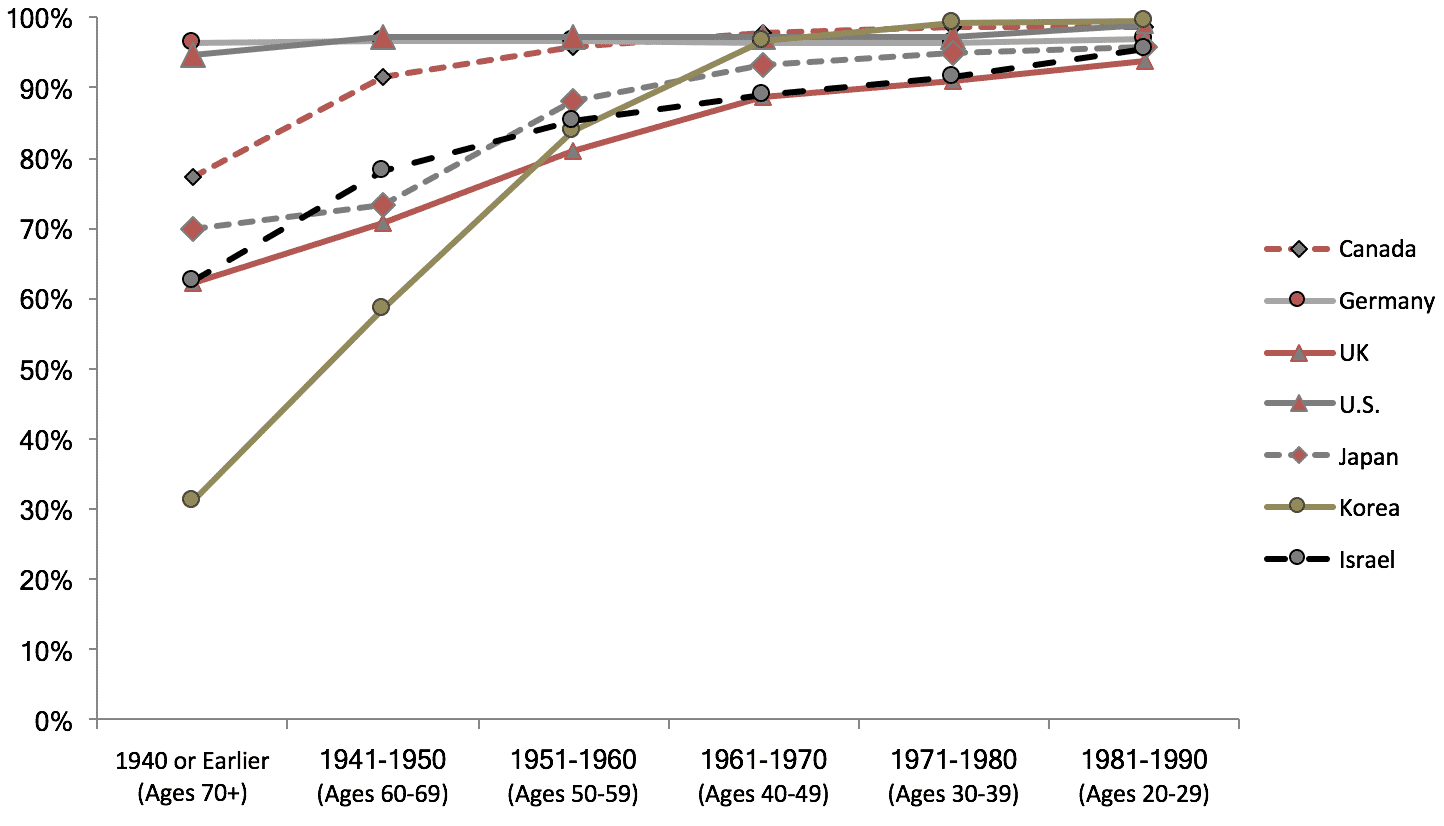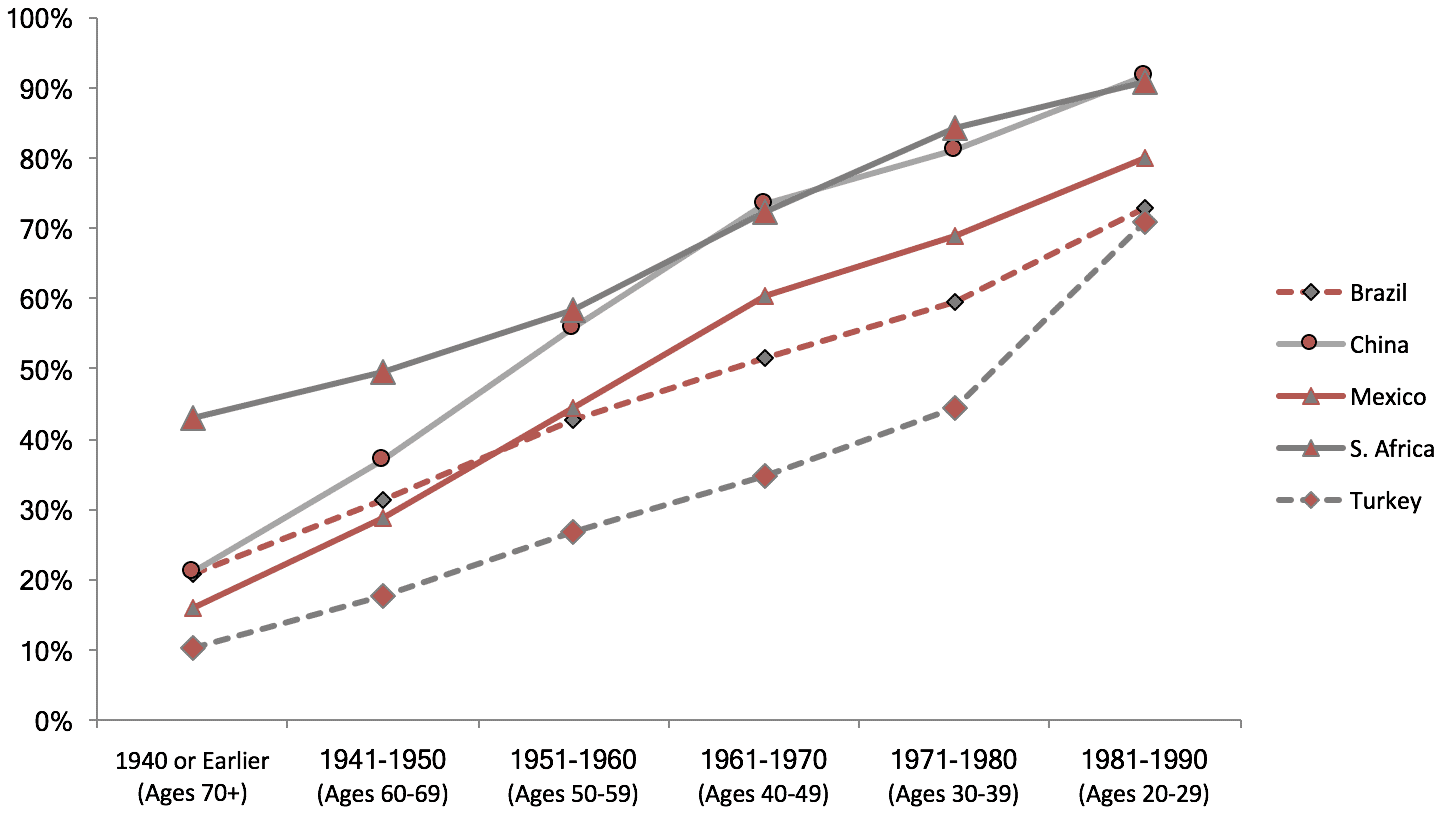Countries around the world are grappling with how to sustain long-term economic growth and competitiveness amid shrinking labor forces. Older people are a key to this puzzle – while large disparities exist, and inequality is on the rise in many countries, this group, as a whole, is living longer and healthier, possesses valuable experience and expertise, and increasingly seeks to remain active and productive. Tapping this productive opportunity requires actions beyond pension reforms; while it has been the primary strategy of governments to date, this approach fails to address the real barriers to older adults’ continuing participation in the labor force. Still in early days, countries around the world are experimenting with more holistic approaches ranging from structural reforms introducing greater flexibility into work and retirement, to combatting softer barriers in employer behaviors like ageism, and to providing older adults with targeted support to remain in or re-enter the workforce.
Among the world’s top 20 economies – a group that accounts for 80 percent of global GDP – India is the only country that will not see its population ages 15 through 64 shrink as a percentage of its total population through 2050. As traditionally defined working-age populations shrink, the percentage of the population age 65 and older in these 20 economies will more than double. This trend shows no signs of reversing – those age 14 and under today account for 22 percent of the population on average. This will fall to 17 percent by 2050.
Missed Opportunity
While inequality persists in life expectancy, health, and education across groups, older people, as a whole, are living longer and healthier and are increasingly better educated. Across the 12 ARC countries, the desire among older adults to remain productively engaged outstrips the opportunity to do so. Most countries are still using or targeting age 65 as the statutory retirement age or pensionable age. This benchmark was first set by Germany – the first modern nation to introduce an old-age pension – more than one century ago, when average life expectancy of Germans was below 40 years. Locked into an outdated mindset of using an arbitrary chronological age and failing to embrace a more flexible and holistic approach to retirement, governments are unable to fully realize the productive opportunity among their older populations.
According to a 2017 survey conducted by Aegon in 15 countries, 57 percent of respondents envision continuing some form of work in retirement, and only 31 percent plan to stop working altogether and enter full retirement. While financial security is the primary driver, 56 percent of respondents cited “to keep active/keep my brain alert” as an important reason to stay productive in retirement, and 38 percent would do so because they enjoy their work.
Percentage of Population with Secondary or Higher Education in ARC Countries

Emerging Economies

Tackling Barriers in Employer Practice
The biggest stumbling block to older people’s labor force participation comes from employers, who very often have discriminated against older workers and are locked into a rigid, binary mindset of retirement. This area also represents the biggest gap for policy efforts, as demonstrated in the lack of government focus on anti-ageism legislation and enforcement. Nevertheless, while labor market structures vary by country, encouraging progress is being made where mandatory retirement is eliminated, support is provided for employment of older adults, flexibility is introduced into retirement, and efforts are made to facilitate older workers’ productive engagement.
According to the 2012 EU Active Ageing survey, more than one in five respondents have either witnessed or been the subject of discrimination in the workplace because they are perceived to be too old. A lack of opportunities to retire gradually by progressively reducing working hours was the most important reason for people age 55 and older to stop working, as cited by 72 percent of respondents. Moreover, 70 percent cited employers’ negative perceptions of older employees as an important obstacle that stops those age 55 or older from working.
The Irodori Project in Japan
In Kamikatsu, a small rural town in Katsuura District, Tokushima Prefecture, nearly half of the population is older than 65, and 86 percent of homes are connected to the internet through a fiber-optic network. It is the site of “Irodori,” a cooperative selling brightly colored leaves. Through the “Irodori” project, local farmers sell some 320 different kinds of leaves grown in the local mountains and fields, which are used for Japanese-style table settings. Senior farmers can access market information, receive orders, and manage shipments via special trackball-controlled computers placed in agricultural cooperatives, and more recently, through the use of special tablet devices that were developed in partnership with telecom operator NTT DoCoMo. Kamikatsu now has a market share of 90 percent for the Irodori leaf and has become a model for how ICT can be leveraged to contribute to the economic development of older adults and rural areas.
Support for Older Adults
Support for older adults’ employability is essential to enhance their competitiveness in the job market, where they tend to be disadvantaged. Compared with barriers in employer practices, this area has drawn greater attention and resources, but government programs tend to be limited to the most vulnerable or offer general support to job seekers rather than tailored offerings that address the specific needs of older workers. However, best practices are emerging that deliberately tap the productive opportunity of experienced professionals and integrate continuing education for older adults into national endeavors to promote lifelong learning.
Across OECD countries, nearly 40 percent of job seekers age 55 or older were unemployed for at least one year in 2016, more than one-quarter higher than the general population. The longer older people remain unemployed, the greater the risk of losing relevant skills or of dropping out of the labor force altogether.
According to a 2016 UNESCO survey of more than 130 countries, 70 percent reported having enacted new policies on adult learning and education (ALE) since 2009, but only 9 percent of countries reported that seniors or retirees are an especially important group for their ALE policies.
Korea Supports Lifelong Learning for Seniors
While Korea has achieved significant improvement in education over the past several decades, and its population ages 20 through 40 has the highest average years of total schooling among the ARC countries, it also has the greatest disparity in educational attainment between older and younger populations. In response, the government has integrated continuing education for older adults into its national endeavors to promote lifelong learning. Korea introduced the First National Lifelong Learning Promotion Plan in 2002, aiming to augment national competitiveness and improve the quality of life of its citizens, and has updated it every five to six years. Realizing the potential of lifelong learning to improve older people’s economic participation and active aging, in the latest Third Plan for 2013-2017, the government placed an emphasis on supporting later-life education, in coordination with relevant policy efforts with local governments. The plan utilizes colleges and local schools as learning centers to provide greater access to educational opportunities for older adults. The Ministry of Education expects that this third plan will help to increase the learning-participation rate of the general population, including older adults, by 15 percent from the 2012 level.
Key Takeaways
Across the 12 ARC countries and around the world, despite variations in culture, economic development, and labor market structure, societies are looking for remedies to a clear and present challenge to their continued growth and competitiveness – the relative shrinking of their working-age populations. Today, the discussion of remedies is unduly focused on reducing the burden associated with a growing retired population, and marked by rigid conceptions of working and perceived zero-sum tradeoffs that only serve to exacerbate intergenerational tension. Comprehensive and enforced anti-discrimination policies are a vital but insufficient first step. While still limited in scope and scale, and often led by non-governmental actors, innovative programs from around the world are bearing fruit and demonstrating the value of a more holistic approach that:
- Introduces flexibility into work, allowing for phased retirement, entrepreneurship, and part-time work;
- Addresses the unique challenges and needs of older workers, offering tailored support and training;
- Recognizes older workers as a rich resource that can be tapped to help address broader societal challenges.
Percentage of Population Ages 15-64 of the Total Population